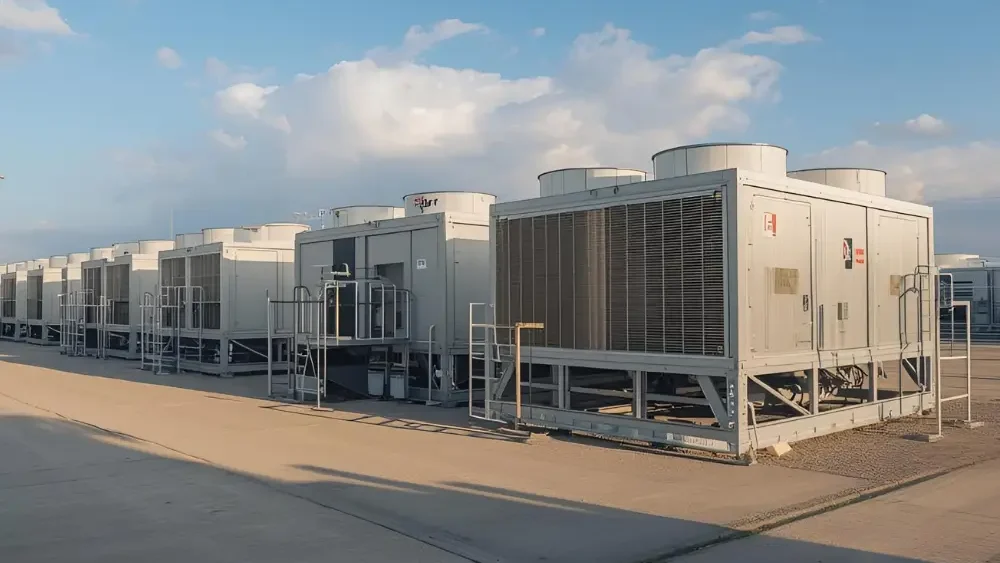When it comes to keeping industrial operations running smoothly, temperature control is non-negotiable. From manufacturing plants to power generation sites, managing excess heat is critical not only for performance but also for safety and compliance.
One of the most vital pieces of equipment used to achieve this is the industrial cooling tower.
At Rapid Energy, we specialise in delivering fast, dependable, and expertly engineered temperature control hire solutions. That includes providing cooling tower rental to help our clients overcome both planned and emergency challenges. But what exactly are cooling towers, and how do they work?

What Is an Industrial Cooling Tower?
An industrial cooling tower is a heat rejection system designed to remove excess heat from industrial processes, HVAC systems, or equipment. Unlike standard air conditioning units, which are designed for comfort cooling, industrial cooling towers are engineered to handle the large volumes of heat generated in commercial and industrial environments.
You’ll typically find cooling towers in:
- Manufacturing plants
- Power stations
- Petrochemical facilities
- Data centres
- Hospitals and large-scale HVAC systems
Their primary role is to transfer waste heat to the atmosphere, ensuring processes can continue without overheating and preventing costly downtime.
How Do Cooling Towers Work?
The principle behind a cooling tower is straightforward: they use water to absorb heat and then release it into the air through evaporation. Here’s the process step by step:
1. Hot Water Collection
Warm water carrying excess heat from industrial processes (or HVAC chillers and condensers) is pumped into the cooling tower.
2. Water Distribution
The hot water is evenly distributed across the tower through spray nozzles, covering a wide surface area.
3. Heat Exchange
The water flows over a “fill” medium – a structured surface that maximises contact between water and air. At the same time, fans draw air upward through the tower.
4. Cooling by Evaporation
As the air passes through, a portion of the water evaporates. This removes heat from the remaining water, cooling it significantly.
5. Cooled Water Return
The cooled water collects in a basin at the bottom, ready to be pumped back into the system.
6. Heat Rejection
The waste heat leaves the tower as warm, moist air.

Types of Cooling Towers
There are different cooling towers to suit various applications. Understanding the main types helps businesses choose the right system for their needs.
Open-Circuit vs Closed-Circuit Cooling Towers
- Open-Circuit Cooling Towers
In an open-circuit system, process water comes into direct contact with air. As the water flows through the tower, a portion evaporates, removing heat. These towers are cost-effective and efficient but require more frequent water treatment to control scaling, fouling, and bacteria. - Closed-Circuit Cooling Towers
In a closed-circuit system, process water flows inside a heat exchanger (usually a coil) and never directly contacts the air. Instead, water is sprayed over the coil and cooled by air movement. These towers reduce contamination risks and maintenance needs, making them ideal where water quality is critical.
Crossflow vs Counterflow Cooling Towers
- Crossflow Towers
In crossflow designs, air moves horizontally across the falling water stream. This makes the system easier to maintain and quieter in operation, but they typically require more space. - Counterflow Towers
In counterflow designs, air moves vertically upward, directly against the downward flow of water. This creates a more compact and efficient design, though it can be noisier and may require more energy to operate.
Why Are Cooling Towers Essential?
Cooling towers are critical in industries where heat generation is unavoidable and continuous. Without them, equipment would overheat, processes could be disrupted, and safety risks would rise sharply.
Key benefits include:
- Operational continuity – Preventing costly downtime due to overheating.
- Energy efficiency – Cooling towers are designed to move large amounts of heat with relatively low energy input.
- Safety & compliance – Maintaining safe operating temperatures reduces the risk of equipment failure or safety incidents.
- Sustainability – By re-circulating water and relying on natural evaporation, cooling towers are more efficient than many alternatives.

Cooling Tower Hire from Rapid Energy
Cooling towers are indispensable, but sometimes businesses need additional or replacement capacity fast. That’s where Rapid Energy comes in with cooling tower hire services.
We provide:
- Planned project support – During site shutdowns, maintenance, or seasonal demand peaks.
- Emergency response – Temporary cooling towers deployed quickly to cover unexpected failures.
- Scalable solutions – From small industrial units to large-scale facilities.
- End-to-end service – Consultation, installation, and ongoing monitoring.

We know that temperature control failures aren’t just technical issues, they threaten productivity, safety, and reputation. Our temporary cooling solutions ensure your operations remain resilient, no matter the challenge.
If your business requires a temporary cooling tower solution, get in touch with us on 0800 464 7025 or by emailing us at hire@rapidenergy.co.uk.
FAQs
1. What industries use cooling towers the most?
Cooling towers are commonly used in manufacturing, energy production, chemical processing, healthcare, and large-scale HVAC systems.
2. What’s the difference between a chiller and a cooling tower?
A chiller removes heat by circulating refrigerant, while a cooling tower removes heat by using water and air through evaporation. In many systems, chillers and cooling towers work together.
3. Can I hire a cooling tower for a short-term project?
Yes. At Rapid Energy, we provide flexible hire options to support both short-term projects and long-term requirements.
4. How quickly can Rapid Energy deploy a cooling tower?
We specialise in rapid deployment, ensuring downtime is minimised in both emergency and planned scenarios.
5. How often do cooling towers need maintenance?
Most cooling towers require routine inspections and cleaning every few months to maintain efficiency and prevent scale or bacteria build-up.
6. Do cooling towers use a lot of water?
Cooling towers recycle most of their water, but some is lost through evaporation and discharge. Water treatment helps reduce waste and improve efficiency.













